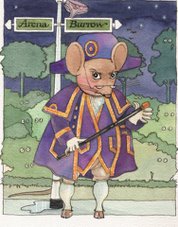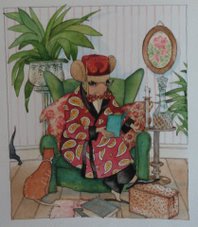
anticant’s father’s mother belonged to a very old family which had inhabited the Saddleworth district on the borders of
Soon after the end of Hitler's war I went with my aunt to visit Mrs Helen Banbery, whose father was the Saddleworth historian, Morgan Brierley of Denshaw House. Her mother, Susan Gartside, was my grandmother's third cousin. Mrs Banbery was by then a very old lady; she had published a memoir of her father (who died in 1897) at the turn of the century, and she was now engrossed in making notes for a mammoth Gartside family novel. "They were a tragic and romantic family", she told us, "and I am making them even more tragic and romantic!" Sadly, she died soon afterwards, and I never knew what became of her novel: I would have loved to have read it.
There is certainly plenty of romance (and romancing) around Gartside family history and, as with most family histories that are handed down the generations, it becomes increasingly difficult as time goes on to separate hard facts from romantic traditions.
The family home, Woodbrow, was built around 1812 by my grandmother's grandfather, Captain Thomas Gartside of the Royal Lancashire Militia (and later of the 11th Light Dragoons, which became the 11th Hussars), possibly after he had retired from active service on half-pay in 1811. Captain Gartside was born in 1777 and died in 1859. His father, Abraham Gartside, a tanner, of Stalybridge, was born in about 1707 in the reign of Queen Anne, but did not marry until 1772 aand died before Thomas, his youngest child, was born. In 1803, Captain Gartside married Mary Anna Reed, the daughter of a wealthy
There are several family legends about Captain Gartside which do not always square with facts gleaned from prosaic sources such as parish registers and army records. Although older generations of the family told me that he served with his regiment in the Peninsular Wars, and was present at the battle of
The second mystery is precisely when and for what reason the "Barracks Cottages" below Woodbrow were built, and how long they were used for soldiers' quarters. The family tradition is that they were required because of the industrial unrest and Luddite outrages during the bleak later years of the Napoleonic Wars; and there is a splendid story of Captain Gartside intrepidly marching his mutinous troops (who sympathised with the rioters) home across the moors from Huddersfield at pistol-point. He was certainly a robust character, and is said to have treated his workpeople harshly. There are also unconfirmed rumours that some of his wealth may have come from association with the slave trade.
Then there is the business of the unburied daughter in the glass coffin. Captain Gartside's second daughter, Josephine, died aged twelve in mid-October 1820, but was not buried until early December. The family legend is that her father was so heartbroken at her death that he had her body embalmed and kept in the house in a glass-lidded coffin until the sanitary authorities forced him to bury her. In fact, it was a double funeral at Heights, as Josephine's baby brother, John Reed, who had died in late October aged one week, was also buried with her. Whatever the reason, a delay of seven weeks in one case and five in the other does seem very unusual. What is certain is that when my grandmother was a little girl, over half a century later, there were still several white busts of Josephine which had been modelled from her death mask and were kept in the cupboard under the stairs at Woodbrow. My grandmother told me that she and her brothers and sisters used to run quickly past this cupboard, as they were scared of these spooky objects. There were, of course, ghosts as well – one a grey cat which was said to appear in the house before a family death.
Captain Gartside built up a business as a woollen weaver and printer at Woodbrow, with his second and third sons, Thomas (1812-1894) and Horatio Nelson (1828-1888), who was my great-grandfather. The eldest son, William Reed Gartside (born c.1806), was disinherited – possibly because of his unorthodox love life: he had several “natural” children before marrying - although he lived nearby at Boosted Edge Farm. Captain Gartside's second daughter, Mary (or Marianne), also got into the parental bad books for several years because she eloped with an actor, "Handsome Jack" Neville who was manager of Queen's Theatre,
Mr and Mrs Neville had a daughter and two sons, one of whom, Thomas Henry Gartside Neville (1837-1910), was first carried on stage by his father at the age of three, and became a prominent
Captain Gartside's descendants lived and worked at Woodbrow throughout most of its existence. My grandmother, Sarah Holden Gartside (1873-1947), who was the tenth child and fourth daughter of H.N. Gartside, was born and grew up there. My great-grandfather was only sixty when he died of cancer in 1888. Tragically, his widow and her eldest surviving son, Charles - a highly thought of solicitor who was
The house, with the farm and surrounding land, was sold by the family trust in 1950/51 for the princely sum of £3,400 - "a most satisfactory result", we were assured at the time! Now divided into two halves, it is probably worth well over £1 million today. Oh, well, that's life.


7 comments:
Anticant
Thank you !
I enjoyed this and would love much, much more.
Your wish will be granted tomorrow, lavender.
and what a superb place....
and even if I had not read the story, I would have immediately thought of ghosts...........the grey cat is rather scary
You surpass yourself again and again.
Do stay with us as long as possible.
Where was the farm?
I lived at the Barracks across the road from Woodbrow from 1990 until 1997 and knew the various owners of the house during that time. I can tell you that it was always looked after and remains in good condition into the 21st century.
John MacMillan
Good morning,
It is 2:26 am and i am just about to go to bed. Very interesting story to read and i would like to know a bit more of course. Also i would love to see more pictures of Woodbrow as we live in Woodbrow House and can not find many pictures / paintings from the times the house has been built in 1812 or any later ones. Thank you
L.
Post a Comment